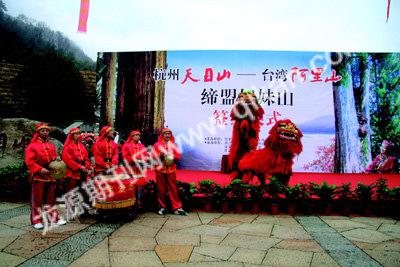Cross-Strait Ties between Two Mountains
2009-06-05XuZhongyou
Xu Zhongyou

On the Morning of February, 2009, the Tianmu Mountain in western Hangzhou witnessed an event in celebration of the establishment of ties between the Tianmu Mountain in Hangzhou and the Alishan (Mount Ali) in Taiwan. A signing ceremony was held. Wang Yi, director of the Taiwan Affairs Office of the State Council, sent a telegram in congratulation of the establishment. Xu Xianzhe, director of Jiayi Tourism Association, Taiwan, and twenty other Taiwan guests, were present at the ceremony. It goes without saying that also present at the ceremony were top leaders of Zhejiang, Hanghzou and Linan.
Situated in Linan, Hangzhou, Tianmu Mountain has two towering peaks face each other. On the top of each peak is a pond. Two ponds are compared to the eyes, thus the name of the Heavenly Eyes Mountain. Tianmu Mountain is steeped in the history of Buddhism, Taoism and Confucianism. The Emperor Qianlong of the Qing Dynasty (1644-1911) visited the mountain twice. During the World War II, this part of Zhejiang Province became the shelter for anti-Japanese forces. Zhou Enlai visited the mountain during the war and met regional resistance leaders there and spoke to the people, calling for concerted efforts to fight the Japanese invaders.
In 1986, Tianmu Mountain was put on the first national list of nature reserves under national protection. In 1996, it joined the UNs Biosphere Reserve Network.
The mountain is famed for its great variety of flora and fauna: 39 species of animals found in the mountain are under the first class national protection whereas three species of plants are under the first class national protection and 15 others are under the second class national protection. The mountain is also a sightseeing attraction. It has a lot of destinations that attract tourists.
Xu Xianzhe talked about the Alishan in his speech at the ceremony. Part of the Yushan Mountain, the Alishan has 18 peaks and with its highest peak at 2,600 meters above sea level. Its gorgeous beauty is much acclaimed. Though the mountain measures only 15 kilometers across, a 72-km-long forest railway meanders and zigzags through all the major scenic spots of the mountain area. It is said that the total length of the railway in the mountain area adds up to more than 1,000 kilometers. The railway goes through 82 tunnels, the longest one being 1,300 meters. A train tour can bring tourists to see the sceneries of the tropic, sub-tropic, temperate and alpine climate in the same mountain. The railway in the Alishan is one of the five great marvels of the Ali Mountain. The other four natural spectacles are the sunrise, the sea of clouds, the evening glory, and the forest.
The forest in Alishan features different species of different climate zones. In the spring, part of the mountain abounds with oriental cherry in best blooming. From February to April, Alishan displays its flower season. A high-altitude forest museum in the mountain showcases hundreds of plant species. Clouds are another spectacular scene. Dawn in the mountain is the best moment to see kaleidoscopic changes of clouds. They can be seen emerging from valleys, seething and surging across peaks, or rolling in from the horizon.
The Tianmu Mountain and the Alishan have a lot in common. Both have ancient history. The Tianmu Mountain has a king of gigantic trees that was loved to death by worshippers whereas the Alishan has a magic tree that was also smothered to death with worship. The Tianmu Mountain has a cluster of gingko trees that are the great grandson, grandson, the son, the father and the grandfather trees flourishing together whereas Alishan has a cluster of pagoda trees that are the son, the father and the grandfather trees growing together.
The Linan tourism department had contacted with the Jiayi Tourism Association on many occasions about making a twin relation of the two mountains. After a few rounds of talks, an agreement for the twin relation was finalized.
Xu Xianzhe and other Taiwan guests spoke highly of the Tianmu Mountain. The people from both sides of the strait agreed that the two sides can benefit each other by promoting tourism together, interacting with each other on the tourism market, sending tourists to each other, exchanging information and visits. These measures will boost exchanges and cooperation in tourism, trade, culture across the strait. □
